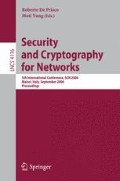Abstract
Cheating in secret sharing has been considered in several papers. Recently cheating in visual cryptography has been considered in [10], where (2,n)-threshold visual cryptography schemes are provided. In this paper we provide new (2,n)-threshold visual cryptography schemes. Our model is different from the one considered in [10]; in particular we aim at constructing cheating immune schemes without the use of extra information, like additional shares or images as done in [10]. We have provided a formal definition of cheating which requires that a group of cheaters be able to deterministically force a honest participant to reconstruct a wrong secret. The (2,n)-threshold schemes that we provide do not allow such cheating, regardless of the number of cheaters.
Access this chapter
Tax calculation will be finalised at checkout
Purchases are for personal use only
Preview
Unable to display preview. Download preview PDF.
References
Blakley, G.R.: Safeguarding Cryptographic keys. In: AFIPS Conference Proceedings, vol. 48, pp. 313–317 (1979)
Blakley, G.R., Meadows, C.: Security of Ramp Schemes. In: Blakely, G.R., Chaum, D. (eds.) CRYPTO 1984. LNCS, vol. 196, pp. 242–268. Springer, Heidelberg (1985)
Ben-Or, M., Goldwasser, S., Wigderson, A.: Completeness Theorems for Non-Cryptographic Fault-Tolerant Distributed Computation. In: Proceedings of STOC 1988, pp. 1–10 (1988)
Carpentieri, M.: A perfect threshold secret sharing scheme to identify cheaters. Designs, Codes, and Cryptography (5), 183–187 (1995)
Carpentieri, M., De Santis, A., Vaccaro, U.: Size of shares and probability of cheating in threshold schemes. In: Helleseth, T. (ed.) EUROCRYPT 1993. LNCS, vol. 765, pp. 118–125. Springer, Heidelberg (1994)
Chaum, D., Crépeau, C., Damgård, I.: Multiparty Unconditionally Secure Protocols. In: Proceedings of STOC 1988, pp. 11–19 (1988)
Chor, B., Goldwasser, S., Micali, S., Awerbach, B.: Verifiable Secret Sharing and Achieving Simultaneity in Presence of Faults. In: Proceedings of FOCS 1985, pp. 383–395 (1985)
D’Arco, P., Kishimoto, W., Stinson, D.: Properties and Constraints of Cheating-Immune Secret Sharing Scheme. Discrete Applied Mathematics (to appear)
Feldman, P.: Non-interactive and Information Theoretic Secure Verifiable Secret Sharing. In: Proceedings of FOCS 1987, pp. 427–437 (1987)
Horng, G., Chen, T., Tsai, D.-S.: Cheating in Visual Cryptography. Designs, Codes and Cryptography (38), 219–236 (2006)
Pieprzyk, J., Zhang, X.M.: Cheating Prevention in Secret Sharing over GF(P t). In: Pandu Rangan, C., Ding, C. (eds.) INDOCRYPT 2001. LNCS, vol. 2247, pp. 79–90. Springer, Heidelberg (2001)
Pieprzyk, J., Zhang, X.-M.: Constructions of Cheating Immune Secret Sharing. In: Kim, K.-c. (ed.) ICISC 2001. LNCS, vol. 2288, pp. 226–243. Springer, Heidelberg (2002)
Naor, M., Shamir, A.: Visual cryptography. In: De Santis, A. (ed.) EUROCRYPT 1994. LNCS, vol. 950, pp. 1–12. Springer, Heidelberg (1995)
Rabin, T., Ben-Or, M.: Verifiable Secret Sharing and Multiparty Protocols with Honest Majority. In: Proceedings of STOC 1989, pp. 73–85 (1989)
Shamir, A.: How to Share a Secret. Communications of the ACM (22), 612–613 (1979)
Stinson, D.R.: An Explication of Secret Sharing Schemes. Designs, Codes and Cryptography (2), 357–390 (1992)
Stinson, D.R., Wei, R.: Unconditionally Secure Proactive Secret Sharing Scheme with Combinatorial Structures. In: Heys, H.M., Adams, C.M. (eds.) SAC 1999. LNCS, vol. 1758, pp. 200–214. Springer, Heidelberg (2000)
Tompa, M., Woll, H.: How to Share a Secret with Cheaters. Journal of Cryptology (1), 133–138 (1988)
Zhang, X.-M., Pieprzyk, J.: Cheating Immune Secret Sharing. In: Qing, S., Okamoto, T., Zhou, J. (eds.) ICICS 2001. LNCS, vol. 2229, pp. 144–149. Springer, Heidelberg (2001)
Author information
Authors and Affiliations
Editor information
Editors and Affiliations
Rights and permissions
Copyright information
© 2006 Springer-Verlag Berlin Heidelberg
About this paper
Cite this paper
De Prisco, R., De Santis, A. (2006). Cheating Immune (2,n)-Threshold Visual Secret Sharing. In: De Prisco, R., Yung, M. (eds) Security and Cryptography for Networks. SCN 2006. Lecture Notes in Computer Science, vol 4116. Springer, Berlin, Heidelberg. https://doi.org/10.1007/11832072_15
Download citation
DOI: https://doi.org/10.1007/11832072_15
Publisher Name: Springer, Berlin, Heidelberg
Print ISBN: 978-3-540-38080-1
Online ISBN: 978-3-540-38081-8
eBook Packages: Computer ScienceComputer Science (R0)

